
Last update PvD
7 Interworking
Customer / Provider interaction
Overview
The service package a single operator can provide is quite limited; any operator is limited in the reach of his network (geographical domain), and the services he can support all by himself (service domain).
If each operator would restrict the services provided to the ones he can provide only by himself, telecommunications wouldn't be that popular.
By connecting to other service operators, the service package can be broadened extensively. The operator can offer those services as his own: 'one stop shopping'.
It implies taking responsibility for a service (billing, quality, ...); the operator acts as a proxy to other operators on behalf of his customers.
A simple example is an international phone call; the local telecom operator can only provide the access to the international network, and has to delegate the rest to international carriers and other local operators.
If the operator gets many complaints regarding international calls, he will take measures against his international provider or he will lose customers. It shows that an operator (service provider) has to take responsibility for the whole service, even if he doesn't have the authority over the whole of the service (he doesn't provide all of it by himself).
The fact that an operator is responsible for the services he sells, also when he has no control over the whole service as it is provided by other operators, presents a special problem to Network Management: for proper management the operator needs to have end-to-end view over the service including the parts of other operators. Note that:
Many services use more than one network (e.g. an international call) and therefore involve multiple owners of these networks. For network management this is reflected in domains: management is restricted to a part of the overall network providing the full service.
The argument to distinguish management domains is authority, which comes with ownership. Within a large network (e.g. national backbone), it is practical to divide operations to various regions. Then the owner of the network is the same, but operational responsibilities (i.e. management, up to a level) is distributed. This results in various sub networks: regional domains.
As access from customer premises to the public network is relatively expensive (it may take up to 50% of the operational cost of a national telephone operator while the access capacity is poorly used) and local access is not vital for the core-business of a wide area operator, the access network is a typical candidate for a local access operator. The primary purpose of an access network is to provide connectivity between customer and the backbone network. It typically carries multiple distinct services (e.g. data, voice and video). The access operator can take the local geographic conditions and penetration into account in a cost-optimised solution. E.g. he may use cable-phone (telephone via CATV-cable) in densely populated areas, or radio access in large rural areas.
Often –and in data communication commonly– the customer has his own local network (e.g. the LAN, or a PABX-network). And any reasonably sized network needs to be managed: management of the customer domain (not to be confused with Customer Network Management). Also, operation of such a customer network could be outsourced.
Another approach –orthogonal to above– is the layered network service (e.g. switched voice over SDH transport), one discerns service domains corresponding to the main types of services provided. Typically, the handling of a Leased Line service is considerably different from handling switched voice or X.25, and therefore justifies distinct management processes. However, the voice network may use a Leased Line service for its trunks; the voice network is layered above the Leased Line network, the voice service is layered on the Leased Lines service.
In fact, with ATM there could be an extra layer for switched services.
A practical distinction which is used here for further discussion, is (according to network ownership):

Clearly, each network owner needs his own Network Management organisation and operation support systems. Within the network of one owner we may discern (according to responsibilities):
Orthogonal to geographic domains, one can have several
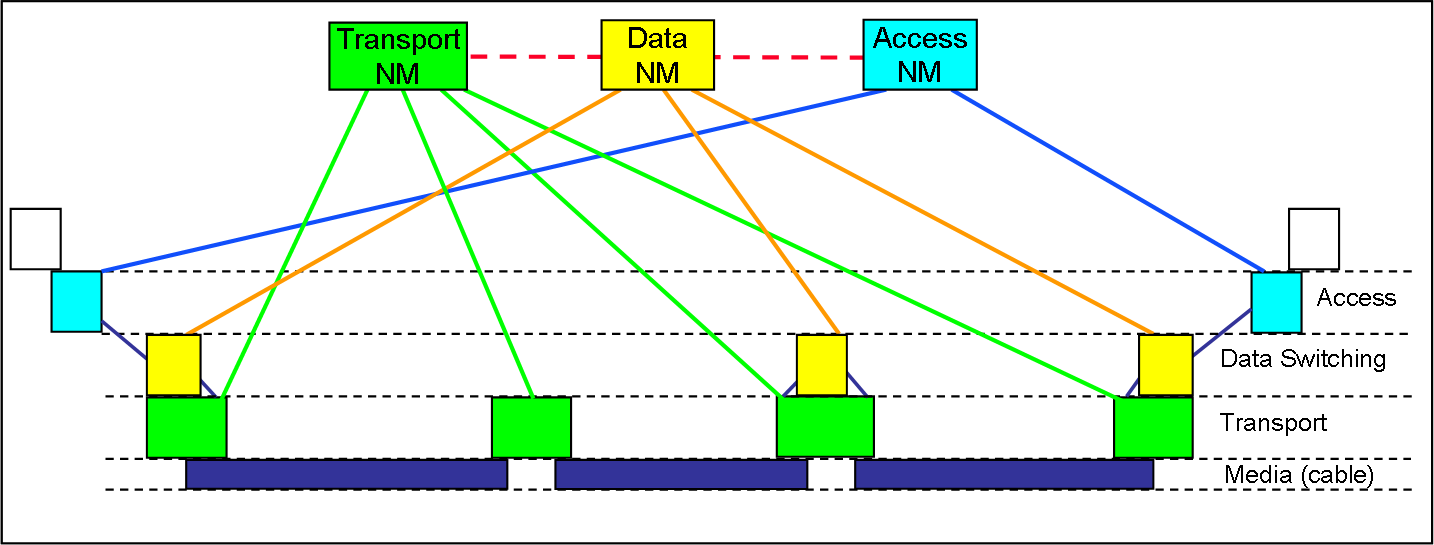
It also shows when an operator will have to use the services of other operators: inter-domain connections (international, mobile, etc.) and Value Added Services, Teleservices (800-numbers, etc.).
Note that when two networks are connected (they apparently have an agreement), their management systems should also be connected one way or the other (i.e. 'manually' or electronically).
{Insert SAPs and NAPs.}
The basic parties in a telecommunications service are the Customer and the Provider: a customer buying a service from a provider. The relationship is formalised in a contract (we elaborate on contracts later). It begins at the management level, in our case in the TMN (also for switched services although this seems less obvious).
In the –not uncommon– case when the service provider has insufficient means to provide all of the requested service by himself, he has to complement it with services of other providers (e.g. the international carriers for international telephone services).
Formally, there is a distinction between a Service Provider and a Service Operator: the Provider always performs the customer-facing, and the Operator implements the required operations (i.e. technical management over the network).
In the extreme case a Service Provider has no network at all and only provides the customer facing; all services are provided by some Service Operator, so for telecom a Network Operator.
An analogon to the Service Provider is a car dealer: as a customer you only interact with him and never with the car manufacturer. You order your car with the dealer; he will order the car at the manufacturer.
Of course, a Service Provider must provide some added value (i.e. operate some service) otherwise his usefulness is at stake. E.g. in the car dealer example such a service is 'car repair & maintenance'. And Service Operators will sell their service (i.e. are also Service Provider), but potentially limited (e.g. only wholesale).
A service provider should not be confused with a retailer or agent who plays only an intermediate role during initialisation, but is not involved afterwards (i.e. an agent may sell a product (e.g. a subscription) but he doesn't provide billing, and you can not complain with him on quality of service).
The roles of the actors/parties involved will vary with the (contractual) relationship; a Service Provider is of course a Provider, but will also have to assume the role of Customer to other providers.
The role is also reflected by the billing process.
The basic Customer/Service_Provider/Service_Operator relationship is:

This may seem a rather artificial construction, but is actually quite normal. For example: You're in a hotel in Belgium and you call a friend in the UK from the hotel. You don't need to have a subscription with Belgacom or BT:
Conclusion: There is no fixed role as Customer or Provider: an operator is both when he cannot provide the full service on his own.
The order sequence to implement a service for a customer by providers is explained by an example. Suppose you want a telephone subscription. The area you live in is covered by a local CATV-operator, providing local telephone services using cablephone. There is also a national backbone operator, who can take care of all non-local calls; however this operator has no local access for your area.
Now there are 3 constructions to facilitate calls.
You can have two independent subscriptions, i.e. a subscription with the CATV operator for transport through his network, and a subscription with the backbone operator. You get two bills, and you have to take care of both subscriptions, and make sure that interworking between these two works. Interworking problems between these two operators are for you to solve: it is the case you want to avoid.
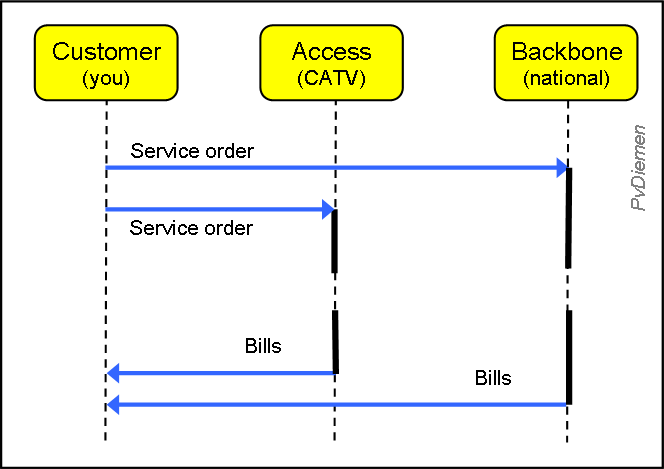
{A typical example of double subscription is when you subscribe to a data service: you have a subscription with the information provider and one with the telecom provider.}
When the access operator provides 'one stop shopping', you can subscribe with him for local and non-local services. Local calls will be handled by the access operator (operating as service operator), and non-local calls are transferred to the backbone (access operator in the role of service provider). Interworking problems are now for the access operator, but he is a direct customer to the backbone. The access operator will aggregate backbone bills with access bills into a single bill. The service scenario will be like:
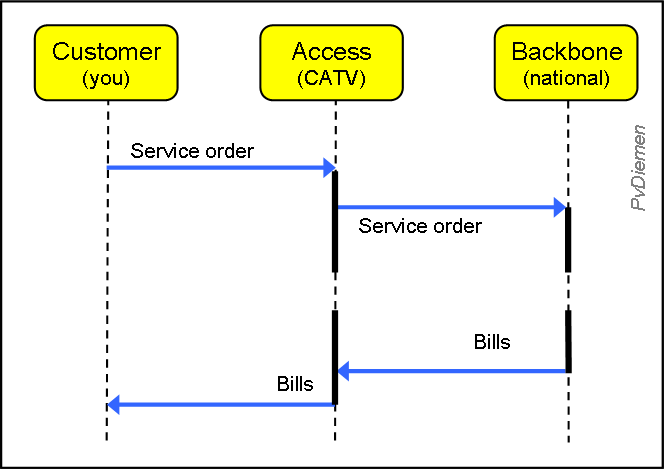
On the other hand, when the backbone operator provides 'one stop shopping', you could have subscribed with the backbone operator. The backbone operator will probably use the local CATV operator to provide access in a cost-effective way. Now he will have to take care of interworking and billing. The service scenario will then look like:
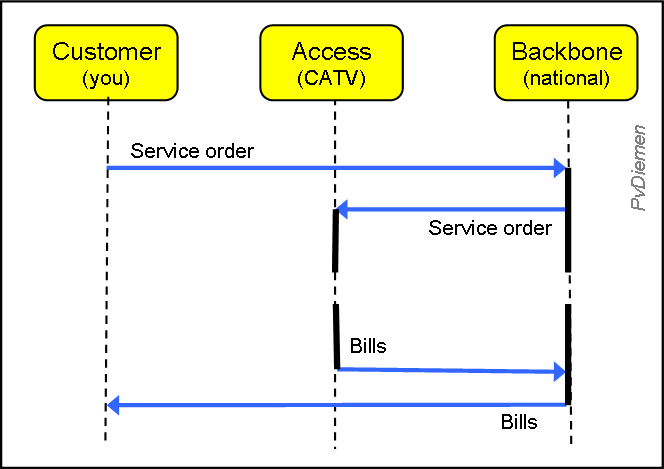
Interworking between operators is similar to above; it is covered more extensively in Interworking Schemes further down.
A single customer may have multiple contracts, each involving multiple users. E.g. a bank (director) may sign a general contract (potentially with SLA and discount) for data communication for all of its local offices (the users). The bank may have similar contracts for other services (voice, leased lines, ...).
The term 'subscriber' usually denotes the case where user and customer are the same person; as for network management this is not necessarily the same person, the term becomes ambiguous so it should be avoided.
So as actors in service interactions we have:
In practice, and in the rest of this document, no distinction is made between Provider and Operator; the terms are used interchangeable unless explicitly noted otherwise.
There are three basic interactions between a Customer and a Provider; they are basically management interactions at SML-level. They are:
Central to any service is the contract between customer and provider (operator). This can be a standard contract (e.g. simple telephone subscriber) or a more elaborate contract with guarantees for a particular level of service (see SLA below), fines for not meeting them, discounts, etcetera.
A contract may also specify management services available to a customer, e.g. what (management) information is sent to the customer on regular basis. Ultimately this results in Customer Network Management.
An operator/provider may (on behalf of his customers) sign a contract with another operator to enhance the extent of service (e.g. extend the reach of the network; usually mutual) or the quantity of services (e.g. add new services to the network). The operator then becomes a customer with the other operator similarly to a service provider. See the Customer/Service_Provider/Service_Operator roles.
The Service Provider will have a contract with his customer, even when he does not provide this service himself.
Note:
Some customers, in particular large customers and customers for which telecom is vital to their respective businesses, will require special contracts stipulating the service level (e.g. availability, error rates, response times). Such (parts of the) contracts are called Service Level Agreements (SLAs) or Service Level Guarantees (SLGs).
Above leads to an entity/relationship something like:
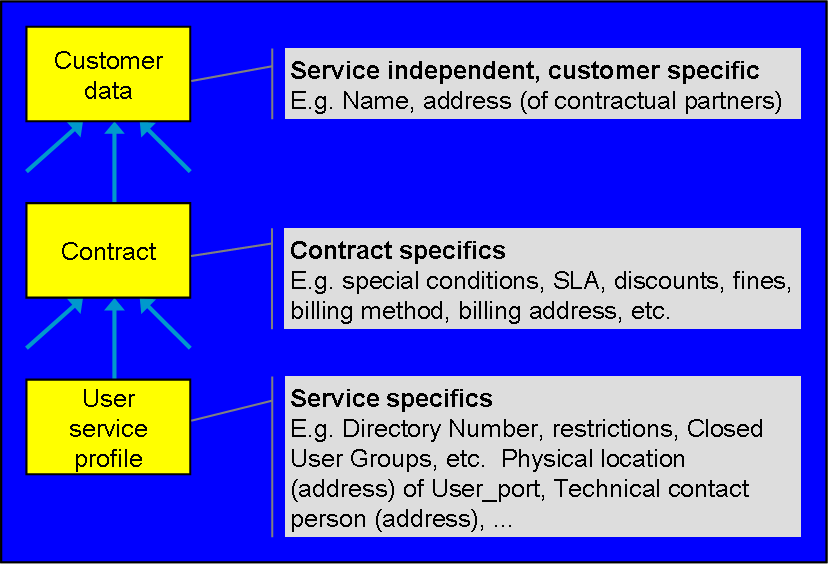
Note that a User Service Profile is present for all contracted services, even when the service is actually provided by another operator.
It may occur that a customer who uses extensive services from an operator, wishes to manage those services for himself. This is called Customer Network Management (CNM). It looks like the services for a particular customer constitute a kind of private subnetwork in the operator's network. Examples:
In many cases 'management' by a customer is only monitoring, i.e. receiving performance data (Performance Management) and problems (Fault Management, Trouble Ticketing). It requires to-the-point condensed reporting on the services used by him and only him.
When the customer also has 'control' over his services (i.e. Configuration Management) there is more to it;
it requires:
The Customer Network Management facilities and/or transactions may be billed as separate services (i.e. on top of the telecom services used).
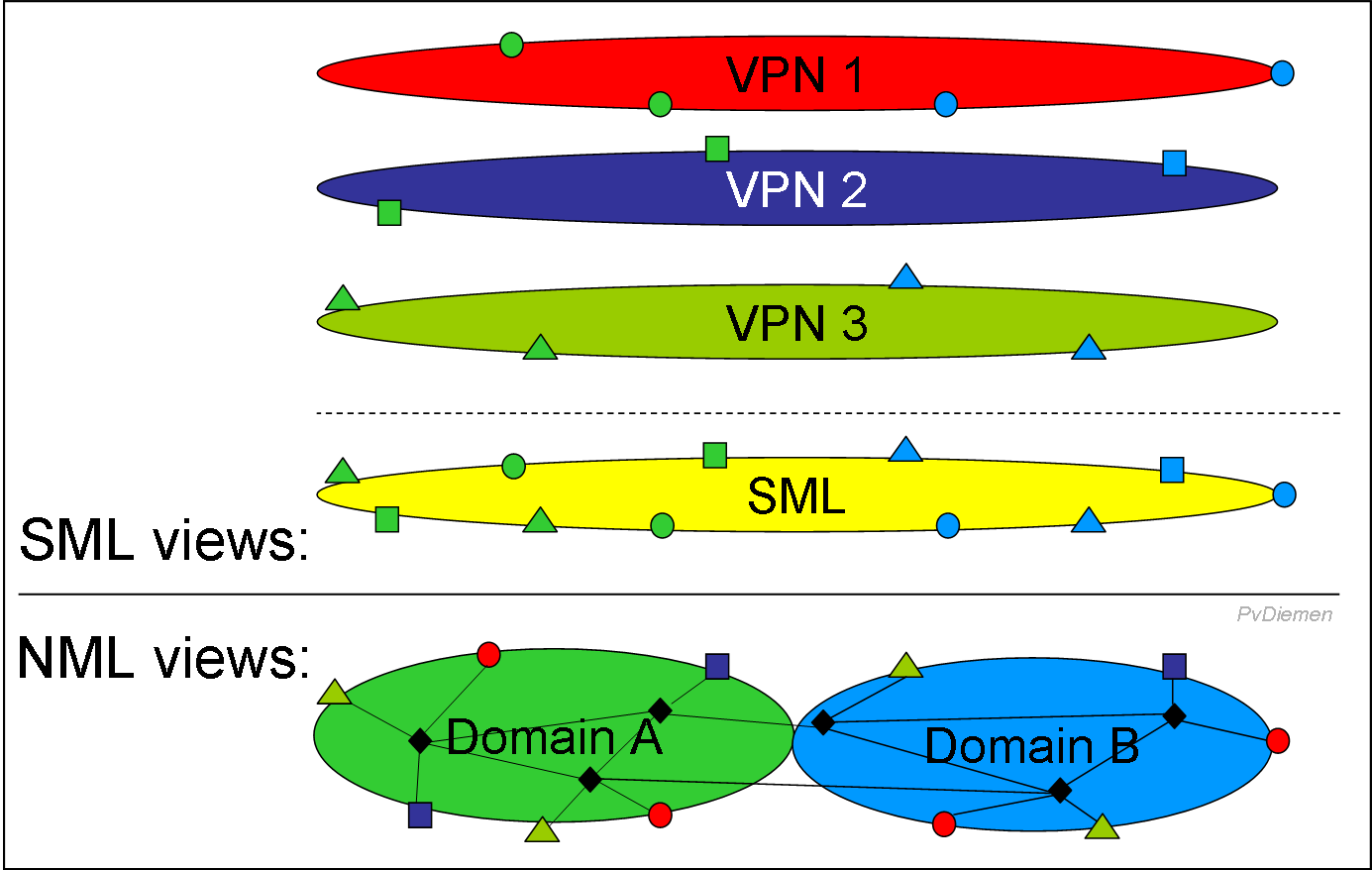
CNM is not to be confused with 'management of Customer Premises Equipment'.
Note that CNM also corresponds to what a service provider (or allied operator) needs in order to properly manage/monitor services over third-party networks.
The following table depicts the levels of control a party may have.
| Level of Control | Parties | ||
|---|---|---|---|
| Service Monitoring | CNM, Service provider | Allied service provider | Full service network operator |
| Service Control | |||
| Network Monitoring | Network-only operator | ||
| Network Control | |||
Partner operators (i.e. operators in an alliance) are usually equivalent to Service Providers (depending on the level op co-operation); Network-only operators only intend to provide network facilities but need to have some basic SML (e.g. wholesale only); the Full service network operators are supposed to be network owners providing the service as well (having full control).
According to recommendation M.3010 all interfacing between a Customer and a Provider is at Service Management Level (SML). M.3010 explicitly allows a Service Provider to connect to the NML or EML of an Operator. Of course this can be permitted by the Operator, and will typically depend on his relationship (i.e. trust, contract) with the Service Provider, and on the security facilities in Network Management in order to restrict control over the network by the Provider. It implies that the Service Provider does have network management operations support over a third party network at his disposal which is equivalent to Customer Network Management.
The following shows some of the potential interfaces between the operators to fulfil a service for a customer. Consider a service (e.g. a leased line connection) which is to cross 3 network domains.
In this case the Service Provider is a pure Service Provider and has no network of its own (for this service). So the Service Provider requires no EML and no NML. However, as the Service Provider is providing service, it should have SML (and BML): it needs to register customer data (name, address, billing control, etc.) and service options (required in any discussion with the customer or the operator).
On its turn, the Service Provider is customer with the Service Operator (he will probably have more favourable terms than the standard customer).
Bills for (all the customers of) the Service Provider are sent from the Service Operator to the Service Provider. The Provider will have to pay the Operator, and see to get his money from his individual customers.
The TMN hierarchical layered model then looks like:
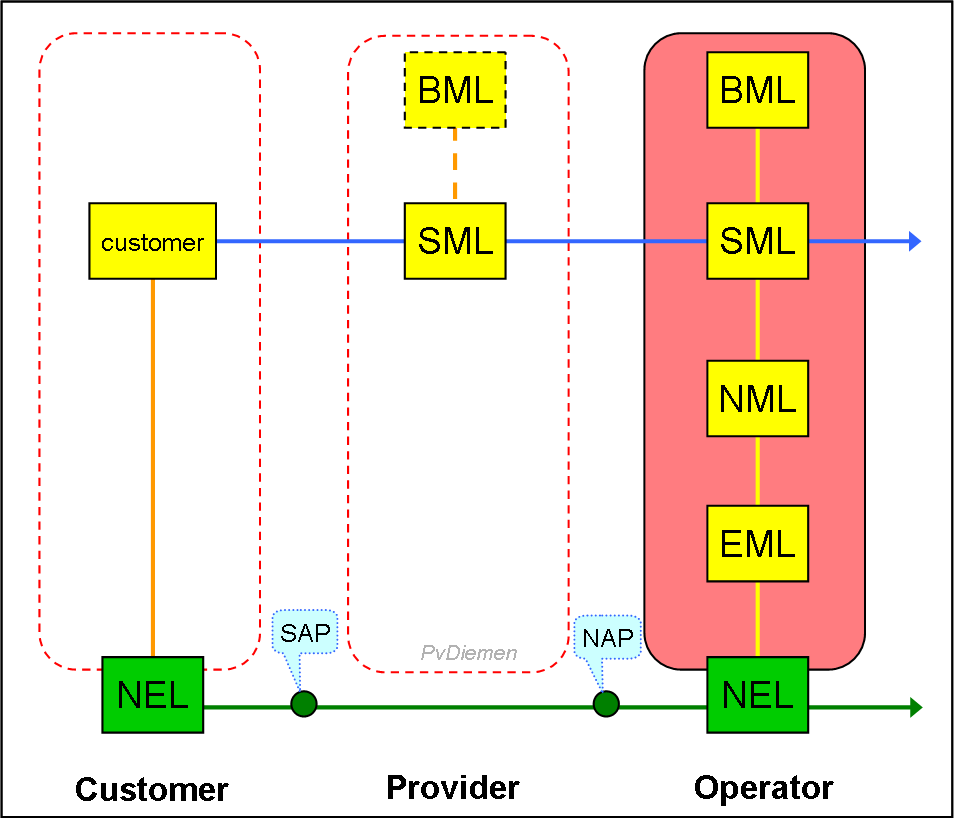
Note:
Now back to the example of a connection through 3 networks through a 'Provider only' scheme:
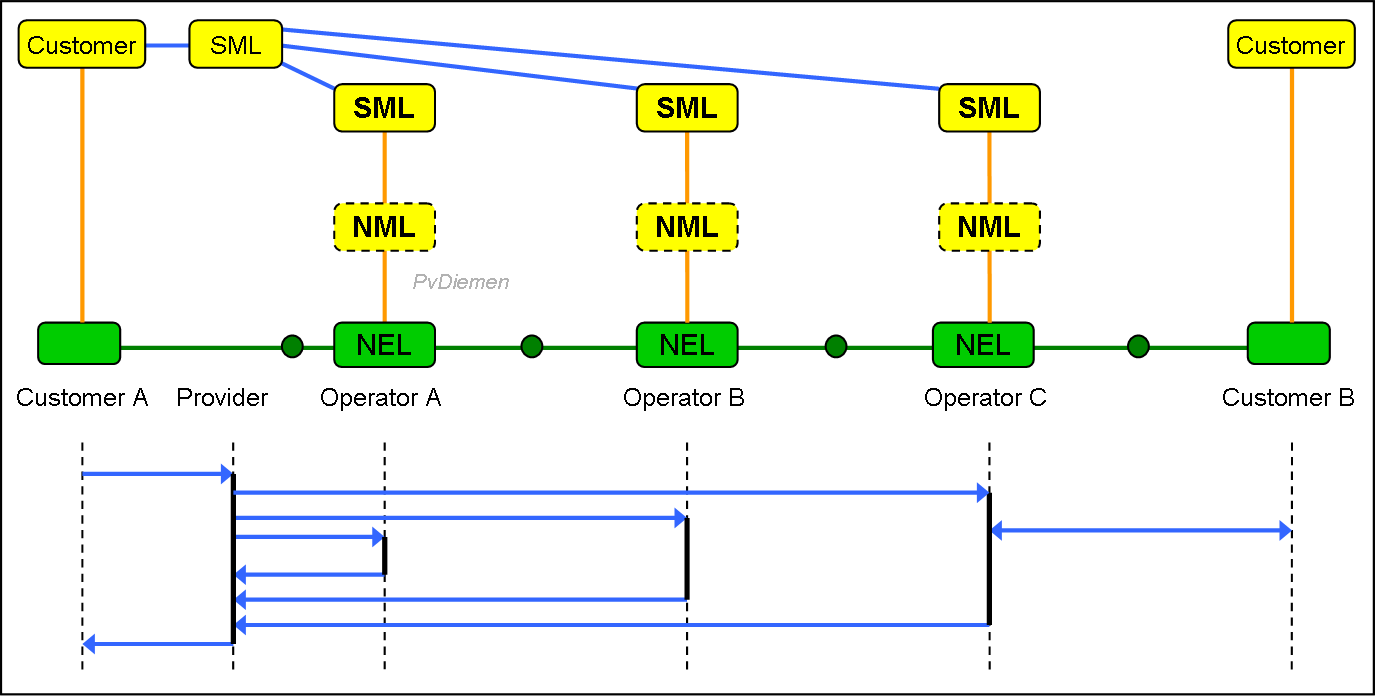
Compare it with a travel agency: they don't operate any airline or hotel, but they know all the flight schedules and they can provide you with a complex itinerary involving multiple airlines and hotels. They take care of the hotel reservations and airline bills.
The operator accepting the service request from the customer is incapable to completely fulfil the service request as it is –at least partly– outside his domain (e.g. France Telecom is incapable to create a Leased Line from Paris to Amsterdam by itself). As this operator wants to provide the full service (one stop shopping), he acts as the primary operator: he can provide part of the service himself (from Paris to the Belgium border), but has to request the rest of the service from other operators (i.e. in the role of customer).
However, as the prime operator has no knowledge of the networks in the other operators' domains, he has to outsource the rest of the service request (i.e. from the French/Belgium border to Amsterdam) to the next operator (i.e. Belgacom).
This operator may, on his turn, not be able to provide all of the requested service, but provide only a part and pass the rest onto still another operator (as is the case in this example; Belgacom provides the connection from the French to the Dutch border, and requests the Dutch KPN a connection from there to Amsterdam).
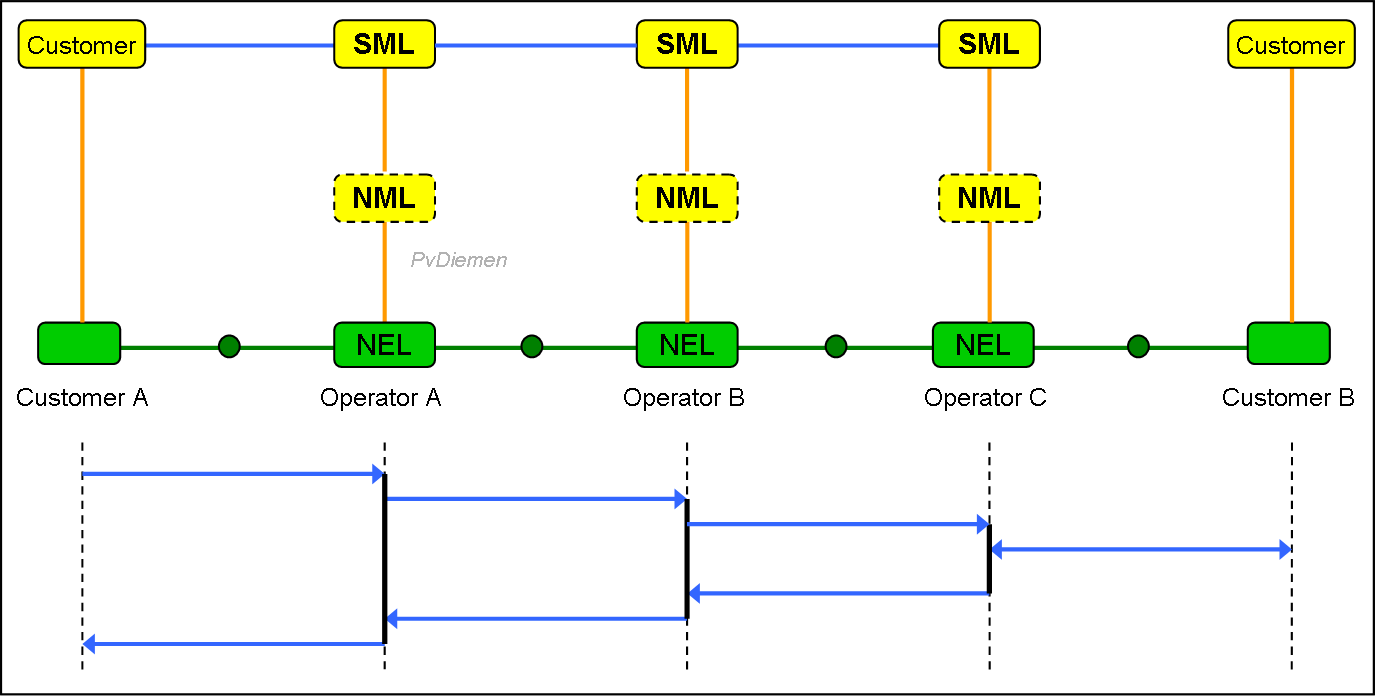
Characteristic to this scenario is that the primary service provider (FT) has no knowledge of all network resources required to fulfill the service request fully. He provides a part of the service and requests the rest from another operator ('pass on the bucket'). Whether this other operator can provide all the rest of the service, which other operators are involved and how the service is implemented, is all hidden from the primary operator. It is a chain of Customer/Provider relationships (in fact the notion 'cascaded' or 'nested' is better as further outsourcing is hidden).
Similar to Chained SML, but now the chaining takes place at NML-level. Note that the SML of the other networks is not used; when the networks are subnetwork domains you don't need all the SMLs; however, when the networks are owned by autonomous operators, they will need SML anyway. Apparently the operators are allied; they allow their allies to do service orders in their network (see also the Allied interworking scheme).
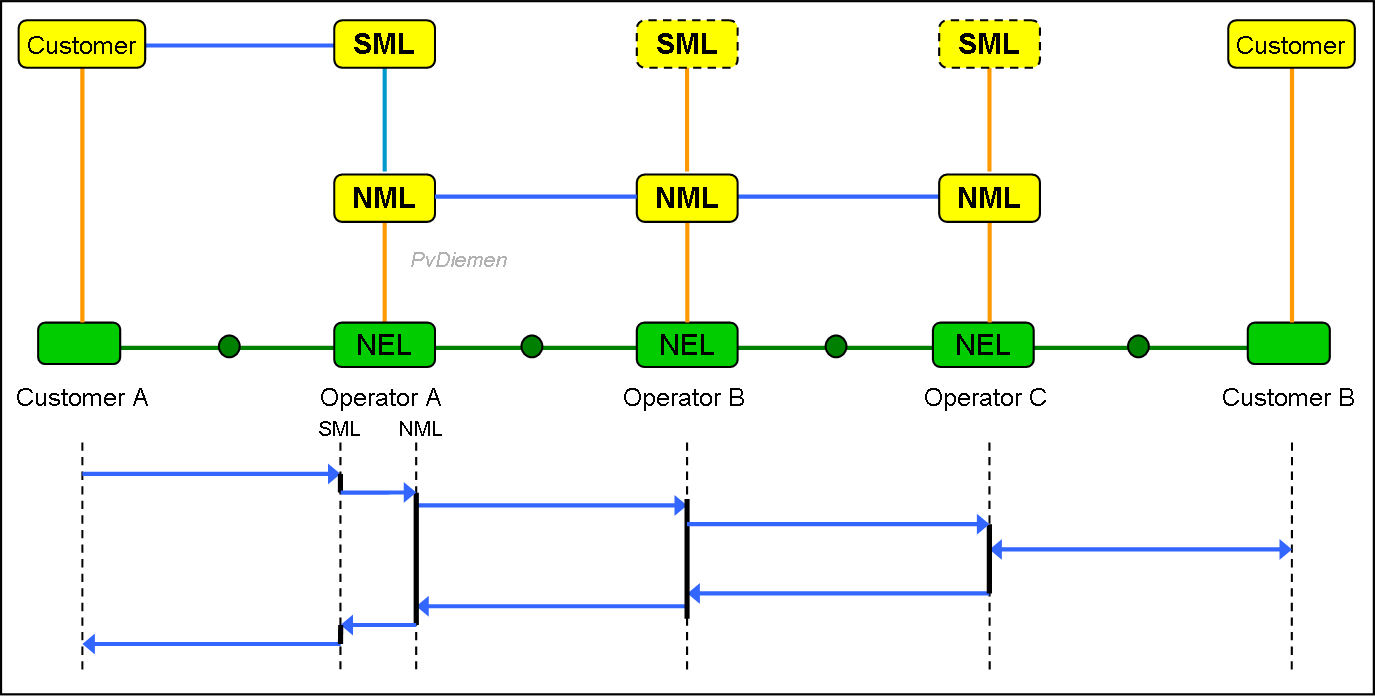
Usage data between the NMLs mutually, and from NML to SML at Operator A will be accounting; from SML to the customer will be billing.
Again, the operator accepting the service request from the customer is incapable to completely fulfill all of the request. However, this time he knows all the service parts, the corresponding networks and their operators. He can now partition the service request, and ask each operator to provide his part.
Characteristic of this scenario is that the primary operator knows the services the other operators' networks can provide, including the Network Access Points (NAPs; gateways, way-points). Most likely there is a framework contract between the operators regarding such services. Potentially the service (access) points of these other networks are known by several other operators.
Note that a customer is in a similar position as the primary operator when he doesn't/can't use the one stop shopping concept: the customer has to negotiate which each operator to provide the part in the decompositioned service.
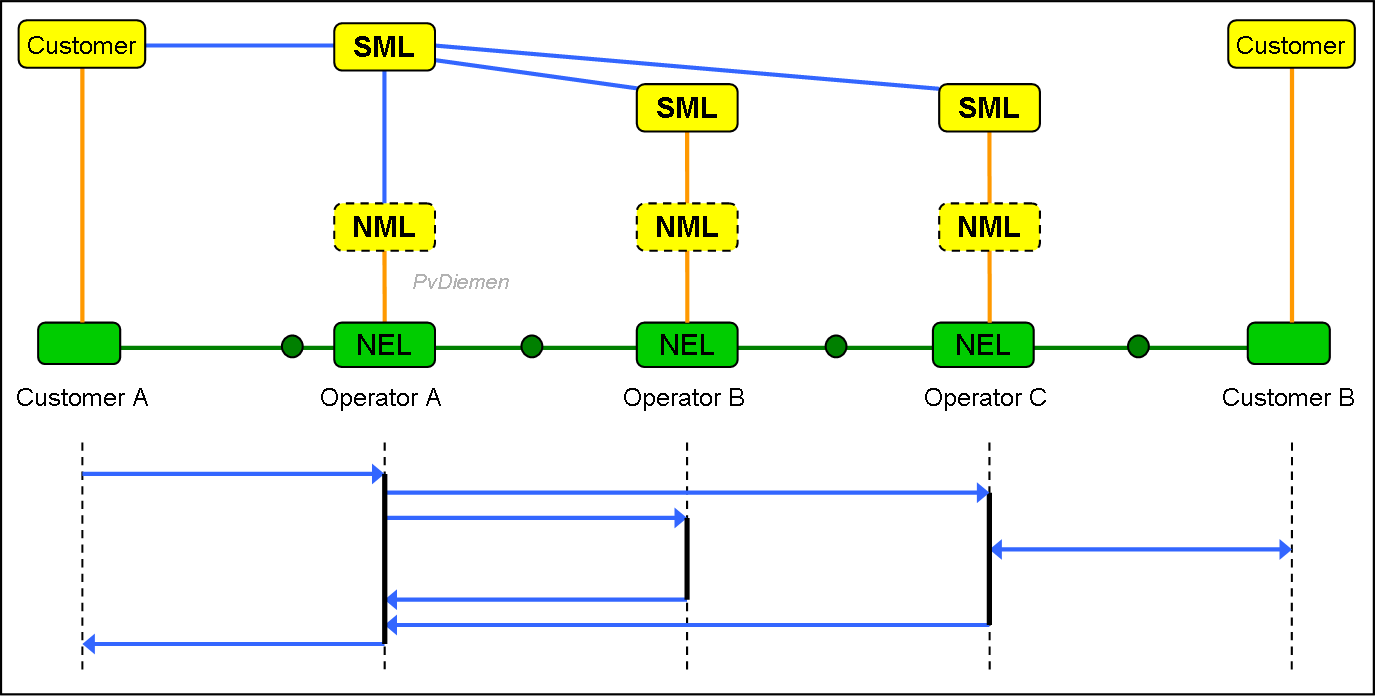
Similar to Partitioned SML, but now the partitioning takes place at NML-level. Here also there is no strict need for SML-centers for all (sub-)networks.
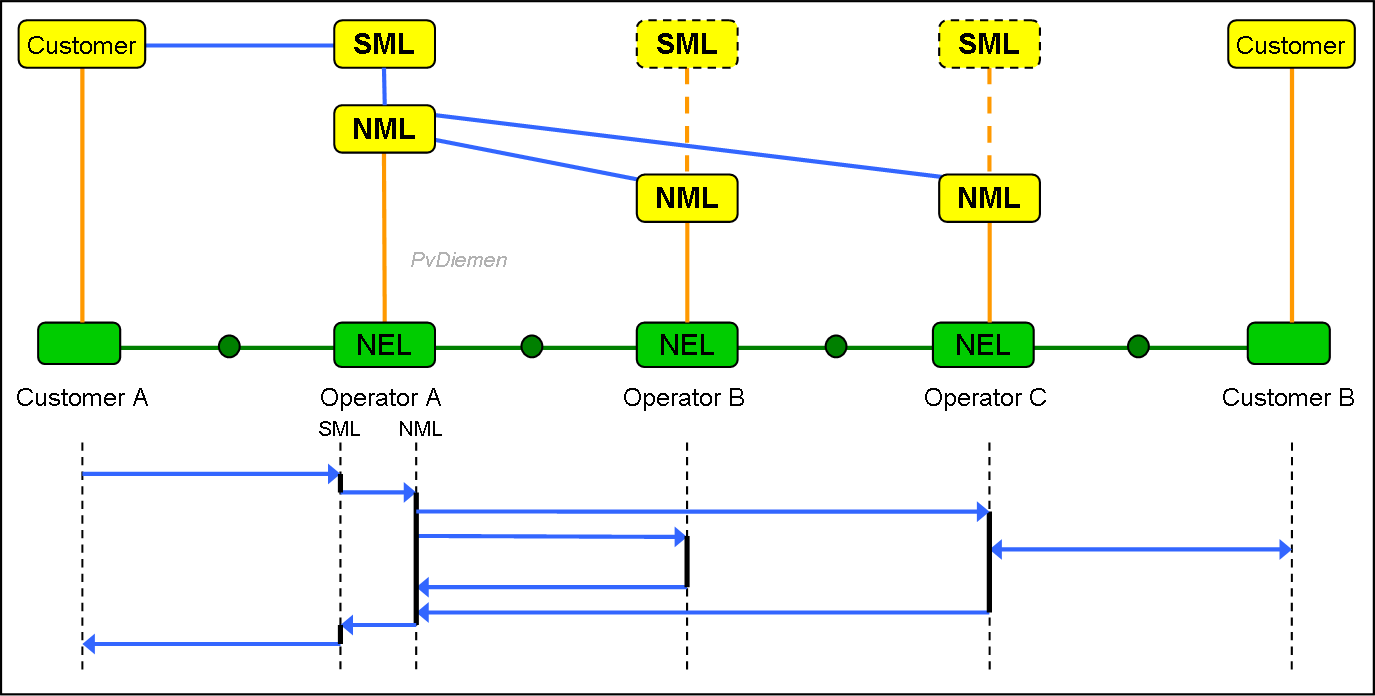
Now the operator accepting the service request from the customer is still incapable to completely fulfill the request, but he has an alliance with one or more other operators; together they can fulfill all of the request. The primary operator knows the other networks and the gateways: he can partition the service request, and implement each part.
Characteristic to this scenario is the fact that the primary operator has extensive knowledge of the networks of the allied operators, and that he is able to implement the service request in the other networks bypassing normal customer processing at SML.
Though there is no strict need for an SML for each network domain, SML's may operate as local/regional respresentatives of the alliance.
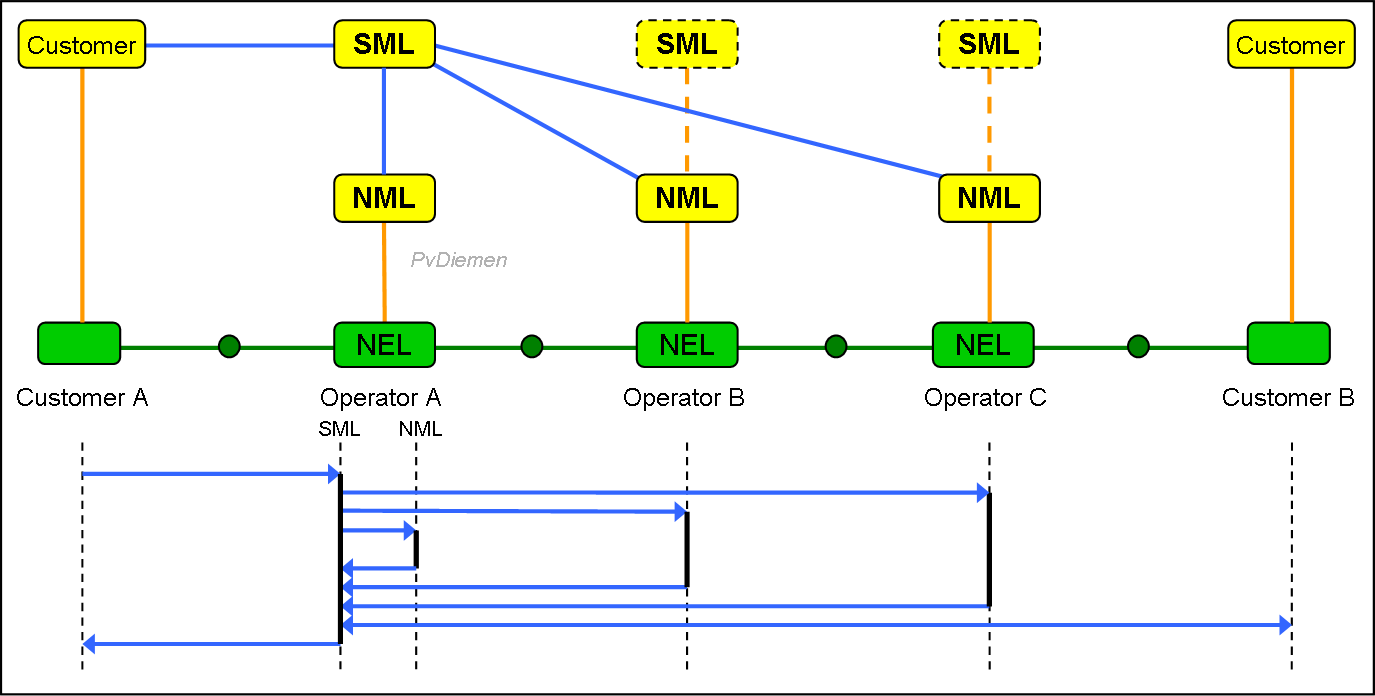
In this construction there is a central organisation at SML level taking care of the end-to-end service across multiple networks.
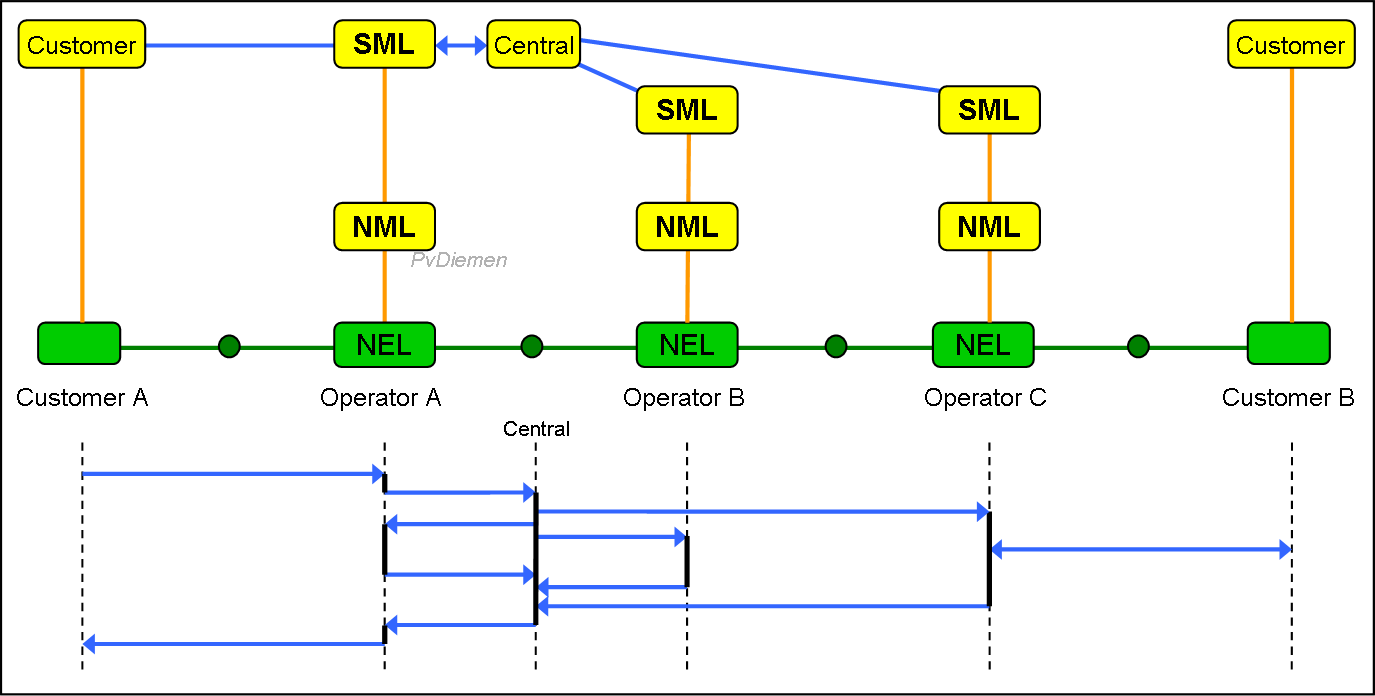
As the customer should not have direct contact with any department other than the SML, request are routed through the SML to a central unit, which will partition the request and send part of the request back to the same SML. The next scheme seems a more likely configuration.
Same as the previous one, but now the central organisation is at NML level (or between SML and NML).
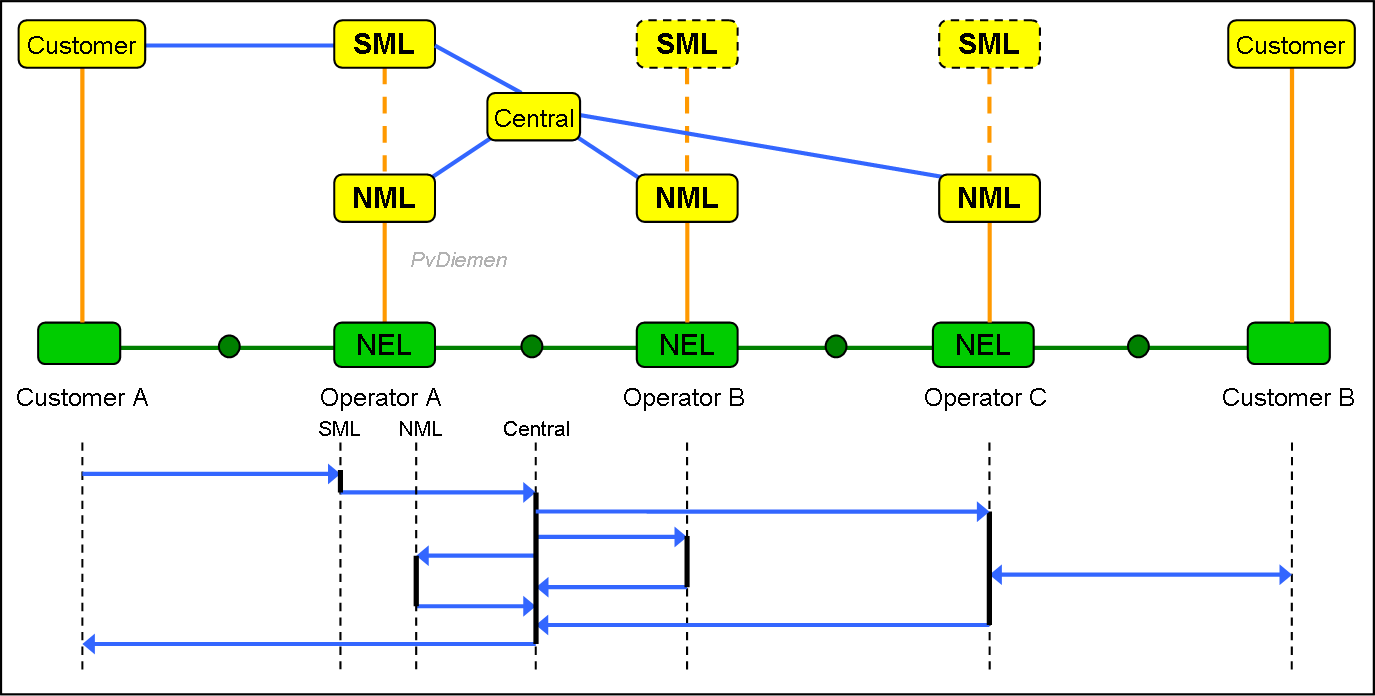
The following table provides an overview of the above described network management interworking. The characteristics highlighted are:
| Construct | Autonomous network | NAPs known externally | Remarks |
|---|---|---|---|
| Provider only | No network, SML only | Yes, of other networks | Particularly suited for mixed services (telecom + value added) |
| Chained SML | Yes | No | Non-cooperating operators |
| Chained NML | No | No | |
| Partitioned SML | Yes | Yes | |
| Partitioned NML | No | Yes | |
| Allianced | No | Yes | Allied operators |
| Hierarchical SML | Yes | Yes | |
| Hierarchical NML | No | Yes | Allied operators |
In real life a mix of above constructions may appear, in particular with the 'Provider Only' construct. Also, some constructs can be used within a large operator when he has a lot of 'regional centres', for example because of difficult geographic conditions (islands, mountains).
There is a striking similarity with travel agencies and airlines.
When you arrange a journey with a travel agency, the agency can take care of everything in the role of service provider(-only). The journey may involve travel by various media (bus, airplane, ship) by distinct operators (in the role of network operator), and additional ('value added') services like hotels.
Usually the travel agency does not provide any transport service itself (i.e. acting as a pure provider), but it could provide part of the transport (i.e. the 'chained' scenario) typically when it is associated with a transport operator (e.g. airline travel agency).
If your destination is not in the airline's network, the travel agency can already arrange the connecting flight with another airline (i.e. the 'partitioned' scenario).
When these two airlines have an alliance with each other, you will get one airline ticket (i.e. the 'allianced' scenario). If an airline does not publish its flight schedules and tariffs, you have to contact their Customer Services (i.e. SML).
Obviously, airlines will provide travel agencies with their network, flight schedules and tariffs, as this is the way to sell more tickets. Something similar is likely to happen in telecom. Actual interworking (interfacing) is a hairy subject; see Standards, Conformance.
In practice the authority of an operator (and his network management) is restricted to a domain. Common domains are:
Within such a domain, one may discern a:
Orthogonal to any geographic division there is a
An operator manages a single domain and has to successively assume the roles of:
Other actors are:
Other concepts:
Customer/Provider interaction is at SML; it is restricted to:
End-to-end service management over multiple domain networks –which is more the common case than the exception– is a special problem for Network Management operators. Various constructs are possible (see Interworking Schemes).
Next section: Integration
Up to Contents
Up to Index
=O=